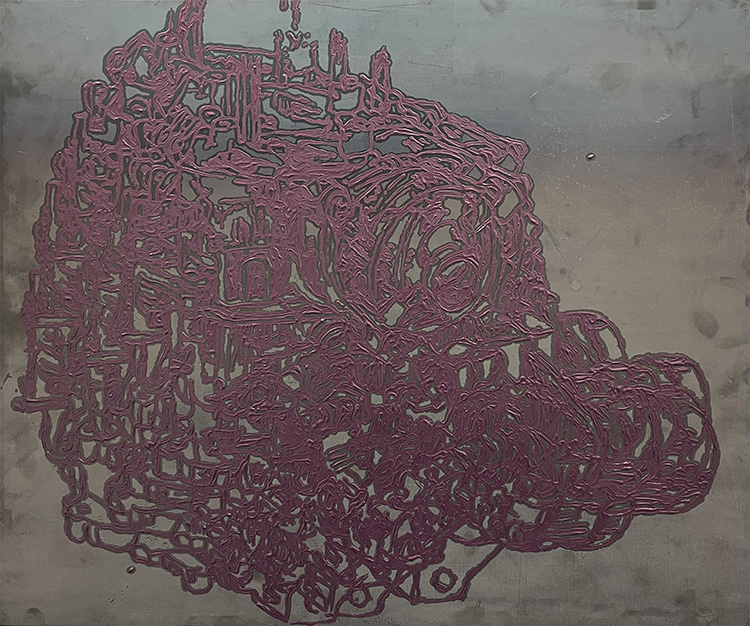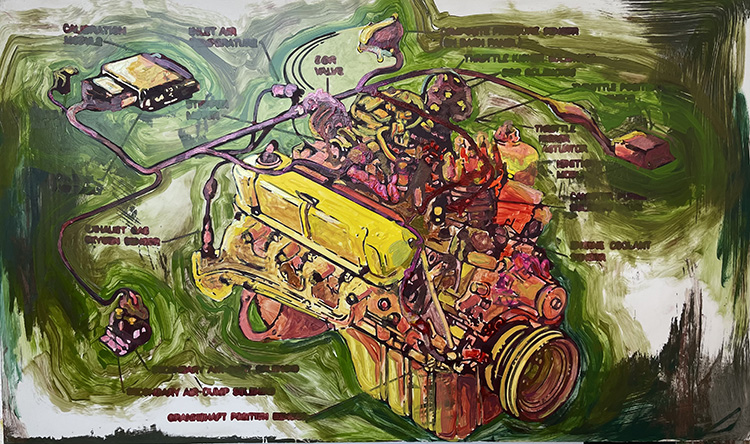See the USA in Your Chevrolet
BFA Thesis Exhibition
These paintings are beautiful, romantic, glorified depictions of classic cars and car parts sourced from automotive diagrams. Classic cars are collected and in their collection they serve as ruins and souvenirs of a tired, yet persistent American identity developed at the height of modernity. They signify desire for an idealized past living on as a fairytale, at odds with the realities of our late-capitalist post-industrial society. My work uses paradoxical combinations of materials, mark making, and aspects of American culture in order to undermine the nostalgia that festers in the gap between the fetishized object and its original context.
While my work celebrates cars, it also points to a critique of this glorification. Within the bright palette are dingy oranges and dull greens that stand for rusting and decaying car parts. Sometimes the paint separates from itself or streaks down the surface of the painting. At other moments the paint is gritty and looks like corroded metal. The palette, finish, and mark-making create a vibrating, humming sensation within the now enlivened car part. My mark sometimes becomes even looser and gives the impression that the form is falling apart. The fantasy, while beautiful and alluring, was always a delusion.
The tension between the utility value of the vehicle and what it has been glorified to signify (i.e, its “display value”) is expressed through the way I paint and choose materials. Because the signifiers of this nostalgic fantasy are carried by the conventions of the car’s exterior—such as shiny chrome and immaculate automotive paint—I allude to these conventions in both the type of support and the quality of paint that I use. I reference actual cars by employing steel or wood panels coated in automotive paint to serve as supports for some of the paintings. The paint is glossy, viscous, and sometimes shimmers from pearlescent pigments. The work is painted with a loose gestural, sometimes sloppy mark and a bright color palette. The liveliness of the mark is juxtaposed with the rigid manufactured surface. This creates an experience for the viewer that reconciles the more emotional and metaphorical experience with the cold, hard, physicality of the car. The fetishized exterior of the car can coexist with the utilitarian guts of the car; they provide context for each other.
The diagrammatic aspect of my work represents these insides and their function in moving the vehicle. The didactic nature of the diagram challenges the romance of the paint. This tension reminds the viewer of the object's use value; it is more than just something upon which to project a fantasy. The paint animates and aestheticizes the sterile diagram, not to perpetuate the reverie of the object but to place it somewhere else. It celebrates the ingenuity of automobiles; the workers who make and fix them; and the culture to which they belong. The diagram’s reminder of the vehicle’s utility does not completely eradicate the nostalgia surrounding it; these values can happily coexist. Use value and display value both have their place in our appreciation of the classic American automobile.
While my work celebrates cars, it also points to a critique of this glorification. Within the bright palette are dingy oranges and dull greens that stand for rusting and decaying car parts. Sometimes the paint separates from itself or streaks down the surface of the painting. At other moments the paint is gritty and looks like corroded metal. The palette, finish, and mark-making create a vibrating, humming sensation within the now enlivened car part. My mark sometimes becomes even looser and gives the impression that the form is falling apart. The fantasy, while beautiful and alluring, was always a delusion.
The tension between the utility value of the vehicle and what it has been glorified to signify (i.e, its “display value”) is expressed through the way I paint and choose materials. Because the signifiers of this nostalgic fantasy are carried by the conventions of the car’s exterior—such as shiny chrome and immaculate automotive paint—I allude to these conventions in both the type of support and the quality of paint that I use. I reference actual cars by employing steel or wood panels coated in automotive paint to serve as supports for some of the paintings. The paint is glossy, viscous, and sometimes shimmers from pearlescent pigments. The work is painted with a loose gestural, sometimes sloppy mark and a bright color palette. The liveliness of the mark is juxtaposed with the rigid manufactured surface. This creates an experience for the viewer that reconciles the more emotional and metaphorical experience with the cold, hard, physicality of the car. The fetishized exterior of the car can coexist with the utilitarian guts of the car; they provide context for each other.
The diagrammatic aspect of my work represents these insides and their function in moving the vehicle. The didactic nature of the diagram challenges the romance of the paint. This tension reminds the viewer of the object's use value; it is more than just something upon which to project a fantasy. The paint animates and aestheticizes the sterile diagram, not to perpetuate the reverie of the object but to place it somewhere else. It celebrates the ingenuity of automobiles; the workers who make and fix them; and the culture to which they belong. The diagram’s reminder of the vehicle’s utility does not completely eradicate the nostalgia surrounding it; these values can happily coexist. Use value and display value both have their place in our appreciation of the classic American automobile.
GM V8 diesel engine-1978 model shown
oil paint and interefence pigment on automotive paint coated panel
24” x 36”
2021
oil paint and interefence pigment on automotive paint coated panel
24” x 36”
2021

Fig. 5-59
from Petersen’s Big Book of Auto Repair
oil paint, oil pastel, and interferance pigment on yupo
60” x 84”
2021
from Petersen’s Big Book of Auto Repair
oil paint, oil pastel, and interferance pigment on yupo
60” x 84”
2021



